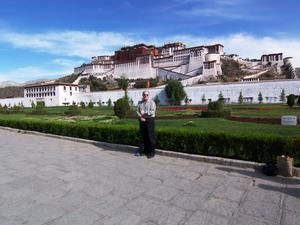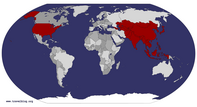Advertisement
Published: September 1st 2006

 Potala Palace
Potala Palace
The goal of my journey is behind me, the Potala Palace, the former home of the 14th Dalai Lama.Train tickets are not sold until 10 days before departure in China, and with 1.4 billion people on the move every day, soft-sleeper tickets, especially to Beijing, are at a premium. Arthur did manage to connect us, so that we would arrive in Beijing on the morning of our exciting departure to Lhasa, Tibet.
One of the world's "great" train-journeys has been made available to adventurous travelers, leaving Beijing at 9 p.m. and arriving in Lhasa, Tibet's capitol, some 48 hrs later.
Since childhood, train travel has always been anticipated as an adventure, leaving the cares to others, while being mesmerized by an ever-changing vista.
This train-ride was to be different from any I have ever taken. This trip was to take me from the East Coast of China, in Taizhou, in Jiangsu Provice to the capitol Beijing and on a non-stop journey to Lhasa, Tibet, also known as " the Roof of the World". It was to take me through 6 of China's Provinces and over 3,000 miles.
The train from Taizhou is a night train, and departs the newly constructed, modern glass and steel station at 6 p.m. every evening, and arrives 12 hrs later,

 Taizhou Train Station
Taizhou Train Station
Taizhou is hometown of President Hu Jintao. He attended school here, and the train-station was constructed much to his credit.the next morning in Beijing.
Other than the passengers, that portion of the train-ride is of no consequence, except as transportation to Beijing. On this train (I have already traveled several times on it), there is no short supply of Chinese, who wish to practice their English.
There have been conversations with eager teachers, successful business-men, active party-members, and shy students, all offering new insight into the amazing changes taking place in their emerging homeland. Neither they nor I are shy to tackle sensitive questions or commentary, and our "good-byes" have always been the friendliest.
Since the "ultimate train journey" from Beijing to Lhasa was not departing until 9 p.m. that evening, we visited with our agent, to make sure payment and "documentation" :-) were in order. By 7 p.m we arrived at the Trainstation-West, one of six railroad-stations in Beijing.
The railroad-complex was huge, and the halls below-ground seemed even more immense and extensive and quite "inhabited". The soft-sleeper lounge was already filled with expectant travellers, and there seemed a general exitement, all of us embarging on a rather unique adventure.
On platform #1, every passenger wanted a photo of the train and the

 View from our Beijing Hotel
View from our Beijing Hotel
Before our departure, we rested in a Beijing Hotel. From our window, the view was quite good, but still limited by the smog problems of the city.plaque, with "Lasa" as the destination. It was only fair that I did the same.
Though our journey started in Beijing, the railroad-line is actually called the "Qinghai-Tibet Railway". A track between Beijing and Xining of Qinghai Province had already existed and had been traveled for decades. But the track from Xining to Lhasa was the new achievement of modern technology and is the pride of modern China. It has been traveled only since July 1st, 2006.
The newest section of track, from Golmud in Qinghai Province spears to almost 16,000 ft. above sea level. Some 900 miles of track has been engineered on permanently frozen earth. It is impossible for a tree to grow at this altitude, and grass has difficulty holding tight to this highest and still growing mountain range called the Himalayas.
I was privileged to live a dream, and travel through the heart of China, over 3,000 miles by train, reaching altitudes of almost 15,000 ft., where breathing becomes a problem. ( In case anyone needed it, Oxygen was available, similarly it is available on an airplane.)
Once we reached those hights, I could feel the pressure on my lungs, and my

 Beijing West Railroad Station
Beijing West Railroad Station
A massive complex both, above and below ground.sleep was frequently interrupted, having to take double breaths, and coping with some queezy and unfamiliar feelings. I felt my body trying to adjust to a different environment and was quite aware of the efforts.
Different passengers were coping with the changes in different ways, a few became quite ill. Most pretended to be the stronger by dismissing the symptoms. I curtailed my activities on board the train by taking everything more slowly and resting frequently on my bottom bunk-bed, and I practiced the pace of my breathing.
I'm not sure if it was the altitude, or the fact that the train was hosting some messy passengers, or because of lesser attention by some "overworked staff", but by the second day, our soft-sleeper-train-car showed the effects of all three abuses.
What was a groomed-sleeper-wagon with clean WC facilities in Beijing, turned into a communal free-for-all, where sinks were used for food preparation on one side, while I was competing to shave in the next. Even the dining car, which was a wonderful refuge on the first night, became less an attraction by the second day, while the quality of food looked and tasted more questionable.
But

 GE engines
GE engines
With GE electric engines, the train was to take us to hights never reached before by a railroad.the friendliness of everyone on the train never subsided, and we enjoyed each other as good family. The ever-changing vista passing our G.E. powered train, as it climbed to greater heights, was greeted by repetitive "oooohs and aaaaahs".
It was quickly obvious, that no passenger had forgotten their camera, and as we compared our digital photos, each "shutter-bug" knew, that he/she had the perfect photo. Little did they realize, that in fact I had captured each memorable moment best. :-)
Great care had been taken to protect the surrounding ecology of the railroad tracks, including the installation of thermal-sensitive steel roods to measure any changes in the frozen tundra soil. The train glides through clean-cut tunnels, raised via-ducts, over descreetly protected railroad tracks. It is flanked by naturally-protective barriers to safe-guard wild-life, such as the distinctive black Yak, the herds of deer, the wild donkeys, and domestic herds of Yak and sheep.
All were grazing peacefully and undisturbed near the passing train-car, to the delight of each passenger. Friendly shepherds were grinning and waved the whole length of the train. Ten years ago they would not have been able to see my friendly response and animated gestures

 obligatory photo
obligatory photo
The shield reads: Beijing to Lhasafrom such a train. That could be of good or bad consequence, depending on one's points of view.
This new train-line was no "trashed" highway of smoking trucks and fuming busses and dripping black oil. These tracks were layed with thought and concern; and it permitted the traveler a view, that will only inspire to love and protect nature more deeply.
Despite all the controversy surrounding the "reason" for its construction, the train seemes as important an event to the Chinese, as for America, when the last "Golden Spike" was driven into the ground to join the East Coast with the West Coast by railroad, with all of "its" consequence.
Around the world, there are serious and emphatic discussions by nations and individuals, each hoping to justify Tibet's history, then and now. Past injustices by developed countries against developing nations plague each one's recorded history, and finger pointing is always a popular sport. For all trans-gressions, history has and will continue to be the judge!
Speaking for myself, I was ecstatic about the opportunity to visit one of the wondrous places on earth, still isolated: where time has changed little, where work is still harsh and

 soft-sleeper-cabin
soft-sleeper-cabin
The young lady was reluctant to have her photo taken. She was on her way to visit her boyfriend in Lhasa. We were 4 to a cabin. I was never quite comfortable having 2 ladies share our accomadations.plenty, where belief and faith are powerful, where the climate can be brutal, and where ancient customs now begin a shaky co-existence with all, that is bitter-sweet in Western culture.
The gigantic Tibetan Plateau covers some 464,000 square miles, and most of the 2 million inhabitants are focused on the less harsh southern region. It includes the Himalayas, with some 70 peaks having an elevation of 23,000 ft.. The mountains are actually the youngest on earth; at 14 million years they are still forming. Most of the plateau is located at an average altitude of over 13,000 feet, where the air is thin, and the intensity of the sun requires great care for skin exposure, and mountain raise another 10,000 feet.
Three of China's great rivers originate here, the Salween, the Mekong, and the Yangzi. Nomads make their pastoral existence in the wide open spaces of the northern part of Tibet. They cling strongly to their cultural heritage, and the many monasteries I visited showed obvious signs of reconstruction, revitalization, and growth in support of that culture.
Lhasa has been the capitol of Tibet since the 7th Century and is dominated by the splendid Potala Palace. Though

 cabin-steward
cabin-steward
This young man was here to take care of our sleeper car, which was wonderfully clean until the first morning.cared for by hundreds of Buddhist monks, the fortress-like palace is a constant and obvious reminder of the conflict between the exiled Dalai Lama and the government of China.
From any direction, the Potala Palace is an impressive sight. Pilgrims by the thousands make their way, as they have for centuries, following pre-determined routes always clock-wise, prostrating, and turning large prayer-wheels, that contain rolls of holy writings.
The Potala Palace is the greatest monumental structure in Tibet, built on Lhasa's highest point. Until 1959, it was the main residence of the 14th Dalai Lama, who sought refuge in India. It has more than 1,000 rooms, and was the center of spiritual and temporal power. Many rooms can be reached only by climbing stairs, that make the climb on a ladder child's play.
My two hour visit within the palace was exhausting, and I slept unusually wonderful that night. No photos are permitted to be taken on the inside, and monks are everywhere to enforce the sanctity of each room and each shrine, many fashioned with great amounts of gold and precious stones. The chapel of the 5th Dalai Lama alone contains a "stupa", that is gilded with

 dining car
dining car
The dining car was also fresh and clean, until the first morning. :-(some 7,000 pounds of gold.
The number of visitors into the Potala Palace is limited to only 2,000 per day. For many the climb is so strenuous, that they give up their efforts long before the end of the tour. Many had a hard time keeping up with an old "geezer" like me.
Out of breath they commented on my fitness in this high altitude. I made it clear in several languages, that I was determined to make the most out of my time in this holy place, which I have sought to visit for so many decades.
Advertisement
Tot: 0.058s; Tpl: 0.015s; cc: 9; qc: 18; dbt: 0.0354s; 1; m:domysql w:travelblog (10.17.0.13); sld: 1;
; mem: 1.1mb
























Richard & Iva Abramowski
non-member comment
Great Pictures
Hello Hans.....We are your sister Resa's in laws. My brother Ron told us about your travelblog. We are enjoying all of your travels . Love the pic's.